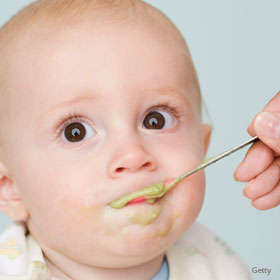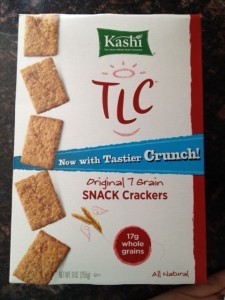Katja Rowell's Blog, page 7
February 26, 2013
three “a-ha” studies that shaped how I thought about food and feeding
 Here are a few of my favorite studies. I have included citations, links, and italics are excerpts from my book Love Me, Feed Me, ‘cus I’m lazy (busy), and heck, it’s already edited and proofed
Here are a few of my favorite studies. I have included citations, links, and italics are excerpts from my book Love Me, Feed Me, ‘cus I’m lazy (busy), and heck, it’s already edited and proofed  What are your favorite studies? Do these make you think at all differently?
What are your favorite studies? Do these make you think at all differently?
1) Pass the Ketchup Please
“Condiments can be your friend. Parents often express a reluctance to serve sauces and dips, worrying the child won’t learn to eat foods plain. Think of ketchup and dips like “training wheels.” You probably won’t have a teenager pouring ketchup on rice or corn on the cob— that is, unless you are fostering or adopting a teenager who comes to you doing that. The bottom line is that condiments help children learn to like new foods.”
take home message: Don’t be afraid of condiments. They help rather than hinder the process of learning to like new foods.
2) Green Bean Study
“Even defining food “rejection” is problematic. Most parents give up on offering a food after only a handful of tries, and studies show that parents aren’t always able to distinguish the process of learning to like new foods from rejection. In one study introducing green beans, babies squinted and frowned with the new food, but with repeated no-pressure exposures, most were eating the green beans after about a week. Interestingly, though the infants were eating the beans, the authors wrote, “Mothers were apparently unaware of these changes in acceptance.” Clearly, quantifying rejection is tricky, and the quality of the feeding relation-ship plays a role in the apparent traits of the child.”
take home message: Parents aren’t very good at being able to tell if an infant “likes” a new food. Keep offering the foods you want them to learn to like to eat—over and over.
3) Mind over Milkshakes
“Consider a 2011 study called “Mind Over Milkshakes.” Study participants were given the same shake and told on the first occasion that it was “sensible” and “no-fat,” and on another occasion they were told that it was rich, creamy, fatty, and “indulgent.” Guess which one they thought tasted better? (It’s the same shake.) Answer: the “indulgent” one. No surprises there, but the new finding was that despite identical calories, fat, and nutrients, what the study participants thought about the shake affected the body’s measured hormone response.
Thinking “indulgence” meant lower hunger-hormone (ghrelin) levels, and presumably, less hunger. “Sensible” (a.k.a., deprivation), meant that the “hungry-hormone” level did not fall as much. In spite of the same intake, these “sensible” shake drinkers had higher hormone levels associated with more hunger.
When we feel “sensible,” or that we have to use “willpower” to get through the day, many of us feel deprived. In the magic that is our mind-body connection, the feeling of deprivation may result in higher hunger-hormone levels. A “sensible” mindset equates to hormone levels associated with hunger. How we think about food affects how much we enjoy it and how our bodies respond. The authors concluded, “Mindset meaningfully affects physiological responses to food.”
take home message: How we feel about food effects how our body uses food and drives our hunger. Eat food that tastes good. Think of all tasty foods as indulgent and creamy. Don’t eat a food just because you think you “should.”
BONUS!!
4) No such thing as too sweet for kids…
Coldwell SE, Oswald TK, Reed DR. Biological Drive For Sugar as Marker of Growth Differs Between Adolescents with High Versus Low Sugar Preference. Clinical Nutrition. 2010;29:288–303. (not original citation, but related link)
“One of my favorite studies looks at children’s versus adult’s preference for sweet taste, and when the shift to adult tastes happens. Through various ages, study participants were asked to add sugar to a drink until it got too sweet.
For children, there was pretty much no such thing as “too sweet.” They continued adding sugar until it wouldn’t dissolve any more. Adults stopped at about the sweetness of soda, finding anything sweeter to be “too sweet.” Interestingly, the point the shift occurred was not by age or from something the children learned in school. The shift to adult taste for sweet tended to happen just after the growth plates in the long bones fused, meaning the children had reached close to adult height, or stopped growing. What that suggests is that there is a biological drive behind that preference for sweet taste. Children are growing, and it makes sense biologically that they would be attracted to sweeter, and therefore higher energy, foods to fuel growth.
Think back to your own childhood. I loved sugar-sweetened cereals at hotels or sleepovers, but I was not allowed them at home, and tended to enjoy large amounts when I had access. However, now as an adult, the thought of that pink, oversweet milk, “marshmallows,” and cereal is off-putting. Children’s tastes mature, and they will do so more readily if we don’t interfere.”
take away message: Children will outgrow their super-sweet tooth. They will do so more readily if we don’t mess with that natural process.
February 21, 2013
Enjoy your cheese and creamy yogurt. Feel-good and taste-good science.
Any time I can find science that doesn’t freak people out, and in fact calms fears, I am thrilled. When formerly demonized foods/nutrients like eggs, salt, coffee, or whatever are rebutted, I jump for joy. For a long time, I’ve been skeptical about the low-fat/fat-free dairy push and hype. Not only skeptical, but worried with the obesity panic that one year-olds are put on skim or low-fat milk and are not getting enough fat. When my daughter was in Kindergarten, she was teased by peers for choosing 1% milk, “That has fat in it, you’ll get fat!” Teens who worry about weight drink diet soda instead of milk…
I’m not here to push people to eat or drink one thing over another. Those are personal decisions. But I am happy to share that a recent review of available research can help allay fears about fat in dairy. If you like full-fat cheese, or 2% milk, if your child only eats whole-fat yogurt, you are not harming your child, and there are those who feel dairy fats are actually beneficial. (Lots of science is ongoing on this topic.) And they taste so, so good (to me anyway.) So, enjoy the milk that tastes good to you and your child—even if it’s whole milk! Enjoy your cheese and your yogurt smoothie…
The study: (from the abstract)
The relationship between high-fat dairy consumption and obesity, cardiovascular, and metabolic disease.
We have conducted a systematic literature review of observational studies on the relationship between dairy fat and high-fat dairy foods, obesity, and cardiometabolic disease. We have integrated these findings with data from controlled studies showing effects of several minor dairy fatty acids on adiposity and cardiometabolic risk factors, and data on how bovine feeding practices influence the composition of dairy fat.
CONCLUSIONS:
The observational evidence does not support the hypothesis that dairy fat or high-fat dairy foods contribute to obesity or cardiometabolic risk, and suggests that high-fat dairy consumption within typical dietary patterns is inversely associated with obesity risk. Although not conclusive, these findings may provide a rationale for future research into the bioactive properties of dairy fat and the impact of bovine feeding practices on the health effects of dairy fat.
Here is what I wrote in my book, Love Me, Feed Me about dairy and fat:
The Dietary Guidelines for Americans (DGA) encourage all Americans to increase intake of low-fat or fat-free milk and milk products to the recommended daily amounts: 2 cups for children two to three years of age, 21⁄2 cups for children four to eight years of age, and 3 cups for those nine years of age and older. Milk is the number one food source of three of the four nutrients the DGA identified as lacking in the American diet: calcium, vitamin D, and potassium.
The following are some thoughts on serving dairy:
Try not to focus on serving recommendations. Aim for an average over several days. If you try to push a certain number of servings every day, that invites pressure, and you know what that does.
No studies show that fat-free dairy for small children lowers body mass index (BMI), and there is concern that fat-free dairy tactics cause some young children to not get enough fat. Infants and toddlers less than two years of age need 30 to 40 percent of their calories from fat, and dairy can help provide that. Another study showed that the kids who drank whole milk actually had the lowest BMI scores of the children studied.
After age two, children need about 25 to 30 percent of their calories from fat. The recommendation is to switch to 2 percent or 1 percent milk at that time.
• Diets too low in fat can result in vitamin deficiencies, as vitamin A, D, E, and K are fat soluble, meaning they need to be ingested with some fat so they can be absorbed by the body.
The bottom line is to enjoy what tastes good. If your teen will only drink 2 percent milk or even whole milk, but it is within the framework of a healthy feeding relationship, I believe you can feel good serving those choices.
February 19, 2013
“mindful” eating, what it is and isn’t, and why kids don’t need it
 A few random thoughts on mindful eating, which seems to be THE buzzword in eating and weight loss circles…
A few random thoughts on mindful eating, which seems to be THE buzzword in eating and weight loss circles…
What Mindful Eating is…
Mindful eating is paying attention
Mindful eating is being curious
Mindful eating is exploring
Mindful eating is permission
Mindful eating is rediscovering one of life’s great pleasures
Mindful eating exercises are a method used to help adults reconnect to tuned in eating, or eating based on internal cues of hunger, fullness AND appetite.
Mindful eating is part of eating competence
What Mindful Eating is Not, or Shouldn’t Be
Mindful eating is not a diet, or a way to get you to lose weight (you might, you might not)
Mindful eating is not about learning to just address physical hunger and deny satisfaction. *
Mindful eating is not a way to abolish “emotional” eating(it’s a way to recognize emotions, and eat with intention and attention)
Mindful eating is not a way to make you eat less (you might, you might not)
Mindful eating is not about restricting your appetite to only one piece of anything (one piece might satisfy you some days, some days you might want none, and some days you might feel like 3 or 4)
Mindful eating is not about the “right” way to enjoy the “right” foods (i.e these rules from a mindful eating handout…“Chew your food 10-15 times per bite. Pay attention to taste and texture and how it changes. Swallow when the food is uniformly smooth. Set down your utensils between bites. Rest for a few seconds before gathering the next morsel. Take a sip of water, tea, or black coffee between bites. Put the proper portions of food on your plate and try to make the meal last at least 20 minutes.”)
Mindful eating (in they way it is used for adults who have lost touch with internal regulation) is not for little kids.
A six year-old doesn’t need to sit and savor every bite of everything she eats. If children are supported with their eating, they will retain their skills of listening to their bodies for signs of hunger, fullness and satisfaction. I’m not saying it’s not fun or interesting for kids to engage in a mindful eating exercise here or there, but kids can tune in to cues from their bodies through other more developmentally appropriate ways. Developmentally, engaging cognitively in the eating and appetite process isn’t necessary if it remains one that is intuitive. If those skills have been lost, mindful eating can be helpful, but must be wielded with caution. Mindful eating that is about losing weight or eating less will feel like restriction and is likely to backfire.
What tuned-in eating looks like for kids:
Eat without distraction (most of the time. The occasional snack in front of the TV is fine.)
Eat with loving adults, in a pleasant setting (not nagging about portions, or veggies, or arguing.)
Have meals and snacks with a variety of tasty foods with low and high fat options, and choices in between.
The child is allowed to eat until he/she is full/satisfied. (Division of Responsibility)
Having enough time to eat (not in snowpants, right before recess where longer meals mean less recess, or eating in the car regularly on the way to karate).
More…
I love this video series, that addresses mindful eating, by my friend and colleague Pam Estes, RD, who runs groups teaching Satter’s “How to Eat” program based on her clinical experience and eating competence research for adults. I love how the words “explore, pay attention, figure out, hear what your body is signaling…” show up.
I also love how this video shows ALL foods. So many eating and nutrition sources pay lip service to “all foods fit” but then you never see or hear about fries or pizza. Notice how the video includes all the “forbidden” foods, and folks of all shapes and sizes. Did you notice that? Did you notice there was candy?
I wonder if you have had an a-ha moment with a mindful eating exercise like I did (I actually like larger bites of food, it’s more pleasant for me, and I still self-regulate, it’s not about making yourself take small bites or eat less!)
* random brilliant comment from a reader about the difference…There are differences between being physically hungry, physically full and satisfied/”done.” There’s that noshy, full but not that full, need something else/something sweet feeling I get sometimes after a meal. I find that if I try to ignore it, I’ll end up going to get something else 1/2 hr or an hr after the meal anyway, so why not just eat it when I actually want it in the first place? I think being able to satisfy appetite in this way is what restrictive dieting rarely allows. You might be able to fulfill physical hunger minimally well, but that flexibility that stops obsessive food thought is gone. And then the failed dieter is called a failure for “emotional eating” in that case. Pleasure and nuance are important, like you said)
February 14, 2013
when “new and improved” is anything but, and tricky packaging
 Usually when a food company “improves” on something, I’m not impressed. I liked my less crunchy, less “tasty” TLC crackers. I can’t stand the new ones. When I told Hubby I didn’t like them, he tried one (he too hates wasting food) and said, “Well, these are just stale.” Alas, I had just opened them. Sigh. So long TLC crackers.
Usually when a food company “improves” on something, I’m not impressed. I liked my less crunchy, less “tasty” TLC crackers. I can’t stand the new ones. When I told Hubby I didn’t like them, he tried one (he too hates wasting food) and said, “Well, these are just stale.” Alas, I had just opened them. Sigh. So long TLC crackers.
Or Raisin Bran “Crunch…” (At least I can still get the original, but once I brought home the crunch by accident…)
Which brings me to another pet peeve if you will allow. When the packaging looks so similar that you bring home something totally different than you want. A few examples:
Morningstar veggie sausage patty, Maple Syrup flavor looks the same as original. NOT the same. Yuck.
Oatnut bread, “high protein,” slightly different shade of green than Honey Oat. Too dense, dry, totally different.
Muir Glen or any other canned tomato that has added stuff in it, like Jalapenos or garlic, when I just want tomatoes. Make the cans look more distinct!
“Mexican” shredded cheese that is cheese with spices in it, versus the “Mexican” blend which is just a variety of shredded cheese…
How about you? Have you been fooled by similar packaging? Miss an original that was “improved?” Moms of picky eaters or children on the spectrum, have you been burned by this issue? Some kids with sensory issues are VERY particular about the brand, texture etc. Lesson I am learning is to slow down when I’m shopping!
Feeding tip: Try not to serve foods in their original packages to small children, or children on the spectrum or with sensory issues. Some kids get stuck on the packaging and demand the same foods from the same package. If you are starting solids, take the foods out of the containers and serve from your own bowls and plates.
P.S, sorry if I’ve “yucked someone’s yum” as my reader shared her favorite phrase…
February 11, 2013
butter or raw tofu block: from the sublime to the ridiculous…
The “fix” to eating mindlessly…
Take the tofu test. “As you grab a snack, ask yourself: Would I be hungry if it were a block of raw tofu? If the answer is no, you’re probably just eating out of boredom. Go for a walk instead!” From a PhD Psychologist at Stanford University
…and this from Cooks Illustrated Light Cook Book on replacing the fat in oatmeal cookies
fruit puree: too dry
egg whites: no flavor
light cream cheese: too thin and crisp
The Winner? Butter. After trying a number of fat substitues, we found that there was no beating butter. The secret was simply to ue less of it. Cookis made with a redulced portion of butter were still “thick and chewy” with a “balanced oat flavor…”
What do you think? Which is more affirming of joy, and the importance of taste and appetite. Is “grabbing” a block of tofu okay? Can’t you mindlessly eat tofu? The first tofu example is dangerously reductionist IMO. One of the key things we forget about (me too in my quick writing) is APPETITE. There is a lot of talk about eating only when you are hungry, so I guess the raw tofu test would work to assess if you were really hungry. (I personally would be on the brink of starvation before raw tofu sounded appealing…) To me, this is disordered thinking. It denies pleasure and nuance, and it’s just, well, silly.
February 7, 2013
chicken drummy stew: easy one pot winner
I love winter food. I love my big red Dutch oven that was a total splurge, that sits on my stove-top and makes me happy. I cook in at twice a week usually, more in the winter. This last weekend, I made this winter staple. I used parsnips. potatoes and carrots, but you can experiment with your root veggies  This is fast to assemble, but does well cooking for a time. Smells wonderful! Forgot to defrost the chicken? No worries, throw it in frozen!! I also like that cooking the meat in the stew gives so much flavor (with the bones and skin) and you can use the less expensive cuts like thighs and drummies.
This is fast to assemble, but does well cooking for a time. Smells wonderful! Forgot to defrost the chicken? No worries, throw it in frozen!! I also like that cooking the meat in the stew gives so much flavor (with the bones and skin) and you can use the less expensive cuts like thighs and drummies.
chicken drummy stew: easy one pot winner

Chicken Drummy stew. total time 2-3 hours, prep time 20-30 minutes (depending on how fast a chopper you are), then another 10 to get the meat off the bones. Serve with thick crusty bread (or not) and enjoy! I used to add garlic and Italian herbs to this, but found that letting the simple ingredients sing was even better on a cold day!
Author: Katja Rowell, MD
Serves: 8
Ingredients
2 Tbspns olive oil
1 leek, cleaned, rough outer leaves removed, diced
1 stalk celery, diced
splash of vermouth or red wine optional
4-12 chicken drumsticks (or thighs, however many you want, with skin and bones.)
3 carrots (peeled and cut into about ½ inch pieces)
3 parsnips (peeled cut into about ½ inch pieces)
4 small potatoes (peeled cut into about ½ inch pieces or slightly larger)
5-10 prunes (pitted, optional for a sweet hint)
1-2 14 ounce cans of diced tomatoes
chicken stock
2 bay leaves
salt and pepper to taste
Instructions
In large Dutch oven, or stew pot, heat EVOO to medium high, sautee the leeks and celery about 5 minutes, add splash of vermouth if you want, and cook a few minutes longer, total about 8 minutes, until limp and softening. Add the chicken legs (have even put frozen legs in) and add enough broth to cover about halfway. Add 1-2 cans of diced tomatoes, reduce to simmering, cover and cook about 40 minutes, until meat is starting to fall off bones (will show near the end of the drumstick.)
Remove the meat with tongs to a platter to cool down and add the carrots, parsnips, potatoes, prunes and bay leaf and simmer covered. After chicken is cool enough to handle, remove meat from the bones, discard bones and skin and put meat back into stew. You can add more stock if you prefer a soupier dish. Salt and pepper to taste. Simmer covered until the potatoes and carrots are done to your liking. Prunes should be very soft and falling apart into the stew.
WordPress Recipe Plugin by EasyRecipe
3.2.1215
feeding tip*: When M was in that naturally picky phase from about 18 months to almost 4, I would separate the stew components into those little compartmentalized plates. Chicken in one section, potatoes in another and carrots in another…
February 4, 2013
“The ‘open lunch bag’ policy works, and the preschool staff love it!”
 Last week at the third and final workshop of the week, a woman approached. She was someone who’s name I should have remembered, but I was at a loss. I have this happen often at workshops, usually right after some tech fiasco, and I’m getting over that stress. Anyway, she was very gracious when I said, “Forgive me, but tell me who you are again?”
Last week at the third and final workshop of the week, a woman approached. She was someone who’s name I should have remembered, but I was at a loss. I have this happen often at workshops, usually right after some tech fiasco, and I’m getting over that stress. Anyway, she was very gracious when I said, “Forgive me, but tell me who you are again?”
She replied that she had been one of M’s teachers at a summer camp a few years ago. M had a great summer, and I remember vividly going in on that first day with M’s lunch, and her lunchbox card (third item under appendix at the top) and making the dreaded speech.
Roughly it goes like this: “Hi, I’m M’s mom. I’m a childhood feeding specialist, and I pack her a balanced lunch including a small treat most days. She does really well with meals and food. I know this may not be how you deal with all the kids, but I ask that at lunch time, please just help her open any containers if she needs it, and then please let her manage her food. Even if all she eats is her fun-size candy bar, or the fruit leather she might get, that’s okay. Please don’t ask her to finish or eat any foods in any order. It’s really less work for you.”
Then I smile obsequiously, not wanting to be “that mom,” but wanting to set the tone. I instruct M to hand the card to any adult who is pushing her to eat in a way she doesn’t like. It has my cell phone number on it. I have never had a call… I didn’t hear much about meals that summer from M or the staff and had forgotten about it until this lovely woman, I’ll call G, raised her hand during the Q and A and talked about how they have an “open lunch bag” policy in their preschool and how it works really well.
G looked around and reassured the audience, roughly half of whom worked in early child care: “It works! You wouldn’t think it does, but they eat more variety and behave better. The staff likes it too since we don’t have to pressure and manage the kids.” Her question was how to reach parents. You see, many parents still ask the staff to enforce ‘this before that’ rules, or even ask the staff to make sure the child eats X, and if he does, then mom will bring a treat at pick up…
It’s always helpful to have folks in the audience back up your message, but I was especially touched when she came up and said, “After we had M in our class and saw how you did things and how well it worked, we instituted the policy. We love it. Not all the teachers do it though. One class they make the kids eat their “real” food first and a little boy was gagging and upset every lunch. He changed to our room and that stopped from day one.”
I was so pleased. I always worry about adding to the burden of staff with my requests, but I have to advocate for my child. I had not heard before that a policy had changed because of it. Usually, teachers marvel at how M eats peppers happily, and digs in to her turkey curry, but they don’t go that next step of looking into their own policies.
At every school M has attended, I offer free staff training, and parent education, and only one preschool has taken me up on it. I’m not sure why. I know that we often get materials about food on that first day, and some of the schools already have dietitians working with them, alas, pushing all the old control messages…
It made my day, and I wanted to share.
What do you think? How can we get this message out? Short of asking G to be at every one of my workshops, how do we start to reveal to staff and parents that children can be trusted with their eating? It seems like a win-win. Kids are more relaxed, staff is less stressed, kids eat better… I gave G a few ideas, but curious what you think.
January 29, 2013
“I’m a synchro girl!” Who knew!
It is with mixed emotions that I am now a “synchro-mom.” I am getting used to spending Saturday mornings and Tuesday evenings at local high-schools with pools with deep-ends and microphones blaring techno music—under water. (Carpooling may soon free up some of those times…)
Part of helping children be healthy and happy is providing opportunities for them to move and be active in fun ways. Along with trips to the park and the local ice-rink or pool and rec centers*, I’ve looked for more organized sports opportunities. I loved being on a swim team (largely for the summer dances with tater tots and DJs that happened after the meets), and running gave me a level of fitness and confidence I could not have achieved with the day to day outdoor play. In high-school soccer, I learned to play with a team, and lose with grace (we were pretty bad.)
M has been less-than-enthused about: karate, tap dancing, creative movement (she was two, it was hysterical), and she has outright refused: swim-team, soccer and hockey. I don’t think kids have to do organized sports to be healthy and happy, but it can be a fun way to move and is a wonderful option. It was amazing to watch her face light up as she got out of the pool (okay, was dragged out) after the first practice. She declared, “Mom, I’m a synchro girl!” (Only later did I find out this involves “knoxing” her hair into a hard little waterproof helmet, which we do for the first time this weekend…) Team sports can help build social confidence, or give an outlet for a social child.
Why I love synchro:
1) Only one week-night practice. Swim team and other sports are usually three nights per week, and I won’t give up my family dinners without a fight. I like them too much, and I have to walk my talk as a childhood feeding specialist. (It throws off our routine, which we thrive on, but it’s worth it. We eat dinner at 4:30 on Tuesdays, instead of a snack a little earlier. She gets home right before 8 pm, usually famished, and has a second go at dinner, sometimes eating it from a thermos in the car.)
2) Our coach is amazing. No nutrition talk, or talk about bodies. Just encouragement and teaching skills.
3) Girls of different ages support one another. I love that the high-school girls are expected to take time to teach the newbies how to do a “walk-over” or “pretty lady.” (I know, I am adjusting to a sport with a move called “pretty lady.”)
4) It builds her skills with listening, following, and eventually teaching others. She relies on her teammates, and down the line will likely perform in smaller and individual aspects as well.
5) There is fun music.
6) There is a level of athleticism and aerobic activity that builds fitness and endurance—without breaking a sweat!
7) At least on this team, there are a variety of body shapes and skill levels.
We’ll see how this plays out, but for now it’s awesome! Has your child found “their sport” yet? How do you deal with the demands of practice and family dinners?
*This is easier for some than others due to financial, time and location concerns, I can only share my experiences here…
January 24, 2013
“time-outs,” not just for kids!
In writing a client summary for the mother of a six year-old selective eater today, I wrote this. (Note this post is about dealing with behavior, not what or how much the child is eating and is a brief bit in a 2-3 page email…)
“Here is what you can say when your son pitches a fit at the table: “I’m sorry you’re sad that we’re not having noodles, there are other options and this is what is for dinner. You are spoiling dinner. Please go to your room (timeout, whatever) until you are ready to come back to the table and be pleasant.”
He may need a little help calming down if that is the case in general. Don’t be afraid to take your own time-outs. I’ve done it. Calmly say, “Mommy needs a time-out, I’ll come back to the table when I can be pleasant.”
I haven’t had to do this for a long time, we’ve been at this for more than half a decade, but I’m so glad that when I couldn’t be rational or pleasant at the table, I had permission to walk away, and I could come back more calm. Taking that breather helped. When you feel yourself getting pulled into the drama, the negotiating, the— let’s face it—screaming… take a time-out. Breathe, cry, go back to the table. (Many mothers described feeling trapped in the cycle of shouting, pressuring and fighting in the middle of that Worry Cycle. This is one tactic to help break that cycle.)
It also shows your kids you are human, and that the rules apply to you too. What do you think?
*Clearly, if you have young children and you are the only adult present, you can’t physically leave the children with the food etc. Perhaps step away from the table, lean over the sink and take some deep breaths. Also, time-outs may not be appropriate for all children, children from hard places, who have experienced trauma or are working on attachment. Use the discipline, behavior and redirection methods you use with success. Also note, there are at least one or two safe and favored options for the child to eat at each meal and snack.
January 22, 2013
Feeding tip: wiping a child’s face, and growing empathy. How does the “feeding machine” make you feel?
I was watching a Charlie Chaplan movie this weekend, and saw this clip of a feeding machine (to boost productivity for factory workers so they could eat and not miss work…)
It made me incredibly uncomfortable, so of course, I want to share it with you. With his exaggerated movements and expressions, CC comes off childlike; his eyes open in anticipation of the food, he is distressed when he can’t get away, or keep up with the pace, or when the “blotter” comes out of nowhere and cleans his face. But gamely, he tries to do what he is told.
How do you feel when you watch it? Can you imagine being fed this way? Alas, it reminds me of various video clips I have seen of dysfunctional feeding cases, and even of certain therapy techniques where children are restrained and forced to eat or drink.
feeding tip: Notice how often his mouth is wiped and how it interrupts, surprises and seems to upset him. If you are wiping your baby or young child’s mouth frequently during meals, particularly if s/he is easily distracted or has sensory concerns, pay special attention to this video. Avoiding frequent wiping may help your child stay calm and focused and less stimulated during mealtimes. Feel free to have a warm washcloth for the end of the meal, or to use if your child indicates she prefers to be clean.
What do you think? Does it help you empathize with a child who is fed in a forceful or non-responsive way? Does it help you look at a practice like frequent face cleaning in a new way?








